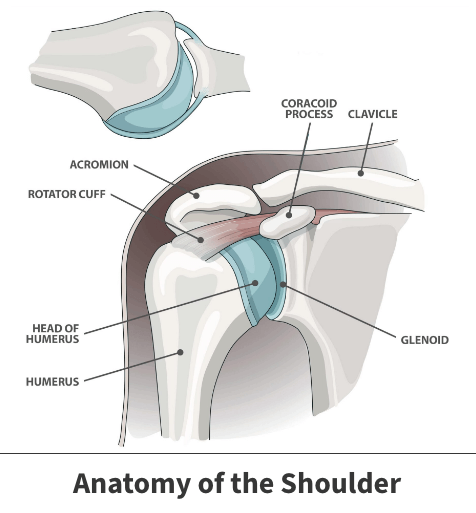Subacromial decompression
Your shoulders are often overlooked, but they are essential parts of your body. They allow you to perform vital tasks, like lifting your arms and carrying large or heavy objects. Unfortunately, shoulder injuries can be quite painful and limit your quality of life.
Several surgical techniques have been developed to address specific shoulder problems. One procedure is known as subacromial decompression.
Anatomy

The shoulder is a complex body part, made up of many bones, muscles, and soft tissues. One crucial component is the shoulder blade bone (scapula). At the very top of the scapula is a small but sharp feature called the acromion.
The acromion is located near several key joints, where soft tissues connect bones like the shoulder blade and collar bone. The acromion is close to other parts vital to the shoulder’s ability to move, like the rotator cuff.
About
Subacromial impingement occurs when the acromion becomes injured or diseased. This happens when the acromion presses against (impinges) the parts underneath it. The most affected part is the rotator cuff tendon, a soft tissue that allows you to move and raise your shoulders.
Causes
When injured, the acromion rubs against neighboring muscles and tissues. Over time, this unwanted contact can cause damage, resulting in pain and other bothersome symptoms. This condition could also develop if the acromion is misshaped or improperly formed before birth.
Risk factors
Though the condition can occur in anyone, a person’s risk increases through:
- Athletic participation – The chances of experiencing this condition are significantly higher in those who routinely compete in sports requiring repeated and intense shoulder involvement, such as volleyball, swimming, baseball, and tennis.
- Physical professions – People employed in jobs that need continual, sharp shoulder movements, including painters, construction contractors, and window washers, carry an increased risk.
- Injury – Physical injury, such as car accidents or falls, can result in acute shoulder damage like impingement.
Medical researchers have discovered that shoulder impingement is a common cause of anywhere from 45 to 65 percent of all shoulder pain cases that have forced individuals to seek medical attention.

Symptoms
Symptoms may vary from person to person and depend on the injury’s severity. But pain should be expected in all cases. This discomfort:
- Often appears when you lift your arms upright
- Can spread from the shoulder’s front to side
- Worsens when you lie on the injured shoulder
- Increases at night and causes sleep disturbances
- Intensifies when reaching behind your back
In the most extreme cases, you might experience swelling or redness in the damaged shoulder, gradual weakness or stiffness in the affected arm, and shoulder and arm mobility issues.
Symptoms typically appear gradually over a period ranging from several weeks to a month or two and worsen as time goes on.
Complications
If your shoulder impingement is not correctly diagnosed and treated, you could experience more severe injuries like rotator cuff tears or inflammation of neighboring tendons (tendinitis).
Diagnosing shoulder impingement
Diagnosis is usually a multi-step process. During the procedure’s first stage, the doctor will carefully examine your shoulder for any visible abnormalities and ask about the injury.
As the process moves forward, you may be asked to perform mobility tests designed to help determine the motion range and pain threshold.
If shoulder impingement is suspected, you may need internal diagnostic imaging tests like X-rays or MRI (magnetic resonance imaging) scans. These allow doctors to capture internal photos of your shoulder to confirm or rule out specific problems or illnesses.
Treatment
Nonsurgical treatments
Commonly employed nonsurgical treatments include resting the affected shoulder, refraining from pain-causing activities, ingesting over-the-counter or prescription pain medications, completing a physical therapy program, or receiving steroid injections.
Surgical Treatments
Subacromial decompression is an arthroscopic procedure. This means that the operation is performed using a surgical tool called an arthroscope. Anywhere from two to four small incisions are made in the injured shoulder. The arthroscope is equipped with a feature called a shaver. This instrument alleviates tissue compression and, if need be, reshapes the acromion to not press against neighboring structures.
Who are the best candidates?
The best candidates for subacromial decompression are those that have:
- Long-standing shoulder pain
- Tried less aggressive treatment methods without any success
- Had other major or lingering shoulder injuries
Preparation
Before having the procedure, you might be required to:
- Undergo any tests or lab work
- Stop taking aspirin or certain pain-relieving medications in the week leading up to the surgery
- Not eat or drink anything in the hours before the procedure
Recovery
In most cases, the procedure is outpatient, does not need a lengthy hospital stay, and you can go home that day. Immediately following the procedure, the repaired shoulder is typically placed in a motion-restricting device, like a sling, for a brief period.
Learn More About Outpatient Surgery
Patients can begin physical therapy shortly after surgery. On average, full recovery takes anywhere from a month to six weeks. Every patient is different and heals at their own pace. Those involved in intense athletic competition might be able to return to their sport within two to three months.
Learn More About Physical Therapy
Preventing shoulder impingement
Accidents can’t always be prevented, but you may be able to reduce your chances of developing the condition through preventative methods. These include:
- Maintaining good posture
- Avoiding overexerting your shoulders
- Immediately addressing even the most minor shoulder pain or inflammation
- Follow suggested exercise techniques
Videos
Related specialties
- AC Joint Injuries
- Atraumatic Shoulder Instability
- Bankart Repair
- Bicep Tenodesis
- Broken Collarbone
- Bursitis of the Shoulder (Subacromial Bursitis)
- Calcific Tendinitis of the Shoulder
- Clavicle Fractures
- Dislocated Shoulder
- Fractures of the Shoulder Blade (Scapula)
- Glenoid Labrum Tear
- Impingement Syndrome of the Shoulder
- Little League Shoulder
- Reverse Total Shoulder Replacement
- Rheumatoid Arthritis (RA) of the Shoulder
- Rotator Cuff Tears
- Shoulder Arthritis
- Shoulder Arthroscopy
- Shoulder Injury: Pain in the Overhead Athlete
- Shoulder Replacement
- Shoulder Separations
- Shoulder Socket Fracture (Glenoid Fracture)
- SLAP Tears & Repairs
- Trapezius Strain (Muscle Strain Of The Upper Back)
- Traumatic Shoulder Instability
